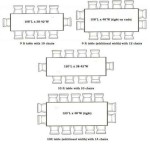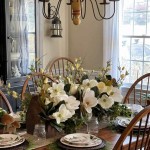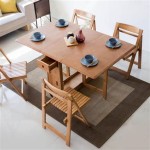The Allure of the Large Oval Dining Table Seating 10
The dining table serves as a focal point within many homes, a gathering place for meals, conversations, and shared experiences. For larger families or those who frequently entertain, a large oval dining table that seats 10 offers a practical and aesthetically pleasing solution. This table size balances the need for ample seating with a visually appealing design that can enhance the overall ambiance of a dining room.
The oval shape, in particular, presents several advantages compared to rectangular or square tables. Its curved edges promote better conversation flow, allowing individuals seated around the table to see and interact with each other more easily. The absence of sharp corners also contributes to a safer environment, especially in households with young children. Choosing a large oval dining table is more than just selecting a piece of furniture; it's an investment in creating a welcoming and functional space for social interaction and shared meals.
Space Considerations for a Large Oval Dining Table
Before investing in a large oval dining table that comfortably seats 10, careful consideration must be given to the dimensions of the dining room. Adequate clearance around the table is crucial for comfortable movement and to avoid a cramped feeling. A general guideline suggests leaving at least 36 to 48 inches of space between the edge of the table and any walls or other furniture. This allows individuals to pull out chairs and walk around the table without obstruction.
To determine the ideal size of the oval table, it is essential to measure the dining room accurately. Visualize where the table will be placed and mark out the intended area on the floor. Consider the placement of other furniture, such as sideboards, buffets, or china cabinets, and ensure that these pieces do not impede movement around the dining table. The table should complement the overall proportions of the room, avoiding overwhelming a smaller space or appearing insignificant in a larger one.
The dimensions of the oval table itself will vary depending on the design and manufacturer. However, a table designed to seat 10 typically ranges from 90 to 120 inches in length and 42 to 48 inches in width. Tables that are extendable, through the addition of leaves, can offer flexibility for accommodating larger gatherings when needed, while maintaining a smaller footprint for everyday use. It is highly recommended to obtain the exact dimensions of the specific table being considered before making a purchase.
Beyond the physical space, consider the visual weight of the table. A dark, heavy table can make a room feel smaller, while a lighter-colored table with a more open base can create a sense of spaciousness. The choice of materials and finishes should be guided by the overall style and color palette of the dining room to ensure a cohesive and harmonious design. Proper planning and measurement are paramount to ensure the perfect integration of a large oval dining table into the existing dining space.
Material Selection and Durability
The choice of material for a large oval dining table significantly impacts its durability, aesthetics, and overall cost. Several materials are commonly used in the construction of dining tables, each with its unique characteristics and benefits. Solid wood, wood veneers, engineered wood, glass, and metal are the primary contenders, each offering a distinct blend of functionality and style.
Solid wood is widely regarded as the premium material for dining tables due to its inherent strength, durability, and natural beauty. Tables crafted from hardwoods, such as oak, maple, cherry, and walnut, can withstand daily use and offer lasting value. Solid wood tables are also relatively easy to repair and refinish, extending their lifespan considerably. However, solid wood tables are typically more expensive than those made from other materials, and they are susceptible to expansion and contraction with changes in humidity, which can lead to warping or cracking if not properly maintained.
Wood veneers offer a more cost-effective alternative to solid wood. Veneers consist of thin layers of wood adhered to a core material, such as plywood or MDF (Medium-Density Fiberboard). Veneer tables can replicate the look of solid wood at a lower price point, and they are less prone to warping or cracking due to the stable core material. However, veneers are susceptible to chipping and scratching, and they cannot be refinished as easily as solid wood. The quality of the veneer and the core material significantly impact the overall durability of the table.
Engineered wood, such as MDF and particleboard, is another affordable option for dining tables. These materials are made from wood fibers bonded together with adhesives. Engineered wood tables are generally more resistant to warping and cracking than solid wood, and they can be manufactured in a variety of shapes and sizes. However, engineered wood is less durable than solid wood or wood veneers, and it is more susceptible to damage from moisture. Engineered wood tables are often finished with laminate or melamine to provide a protective surface.
Glass tabletops offer a modern and elegant aesthetic. Glass is easy to clean and maintain, and it can create a sense of openness in a dining room. However, glass is prone to scratches and can be easily chipped or shattered. Tempered glass is a more durable option, but it is still susceptible to damage. Glass tables are often paired with metal or wooden bases to provide support and stability.
Metal dining tables are known for their durability and industrial-chic style. Metal tables are resistant to scratches and stains, and they can withstand heavy use. However, metal tables can be cold to the touch and may require the use of placemats or tablecloths for added comfort. Metal tables are often combined with wood or glass to create a more balanced and visually appealing design. When choosing a material, consider the balance between aesthetics, durability, maintenance requirements, and budget.
Design Styles and Aesthetic Considerations
The design style of a large oval dining table should harmonize with the overall aesthetic of the dining room and reflect the personal taste of the homeowner. Dining tables are available in a wide range of styles, from traditional and formal to contemporary and casual. The design style encompasses the shape, materials, finishes, and detailing of the table, all of which contribute to its overall visual impact.
Traditional dining tables often feature ornate detailing, such as carved legs, decorative aprons, and intricate inlays. These tables are typically made from hardwoods, such as mahogany, cherry, or walnut, and finished with rich stains and polished surfaces. Traditional tables often evoke a sense of elegance and formality, making them suitable for more formal dining rooms.
Contemporary dining tables tend to have clean lines, simple shapes, and minimalist detailing. These tables are often made from a combination of materials, such as wood, metal, and glass. Contemporary tables may feature geometric shapes, asymmetrical designs, and bold color accents. They are well-suited for modern and minimalist dining rooms.
Rustic dining tables emphasize natural materials and a handcrafted aesthetic. These tables are often made from reclaimed wood or distressed finishes, showcasing the natural grain and imperfections of the wood. Rustic tables may feature chunky legs, live edges, and visible joinery. They are ideal for creating a warm and inviting atmosphere in a dining room with a farmhouse or bohemian style.
Mid-century modern dining tables are characterized by their clean lines, tapered legs, and organic shapes. These tables are often made from wood, such as teak or walnut, and finished with a clear lacquer to highlight the natural grain. Mid-century modern tables often feature simple detailing and a focus on functionality. They are well-suited for dining rooms with a retro or vintage aesthetic.
In addition to the overall style of the table, consider the color and finish. Lighter finishes can make a room feel more spacious and airy, while darker finishes can add warmth and sophistication. The finish should be durable and easy to clean, especially if the table will be used frequently. Upholstered dining chairs can complement a formal dining table, while simpler chairs made of wood or metal will be suit more casual dining spaces. The chosen style must offer both aesthetic appeal and functional practicality.

Antique Regency Oval Pedestal Table Extremely Large Revival Dining To Seat 10 12 People

Oe Fashion Wooden Top Long Dining Table 10 Seats Seater View 8 Details From Foshan Furnitur

Large Antique Oval Table 7ft Long Formed Regency Revival Mahogany To Seat 10 12 People

Dining Tables Seating From Ten Up To Twenty People Oak Furniture Uk

Serpent Double Dining Tables Tom Schneider

Oval Tables Size Variations Table Dining Room Sizes

Serpent Double Dining Tables Tom Schneider

Oval Dining Tables Kitchen Pottery Barn

Dining Room Tables That Seat 10 12 Best Color Furniture For You Check More At Http 1pureedm Com 2

The 7 Best Dining Tables And How To For One Reviews By Wirecutter








